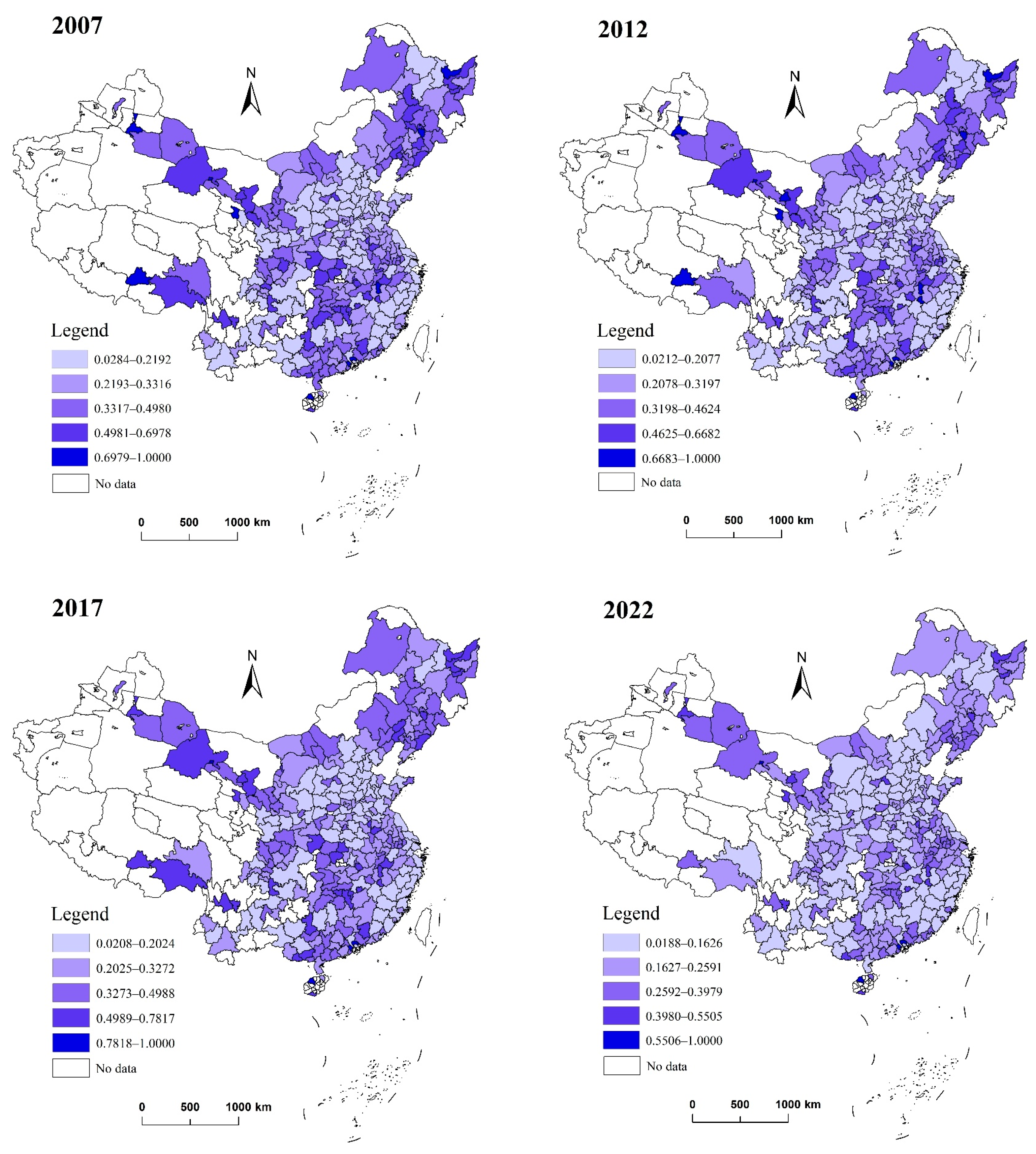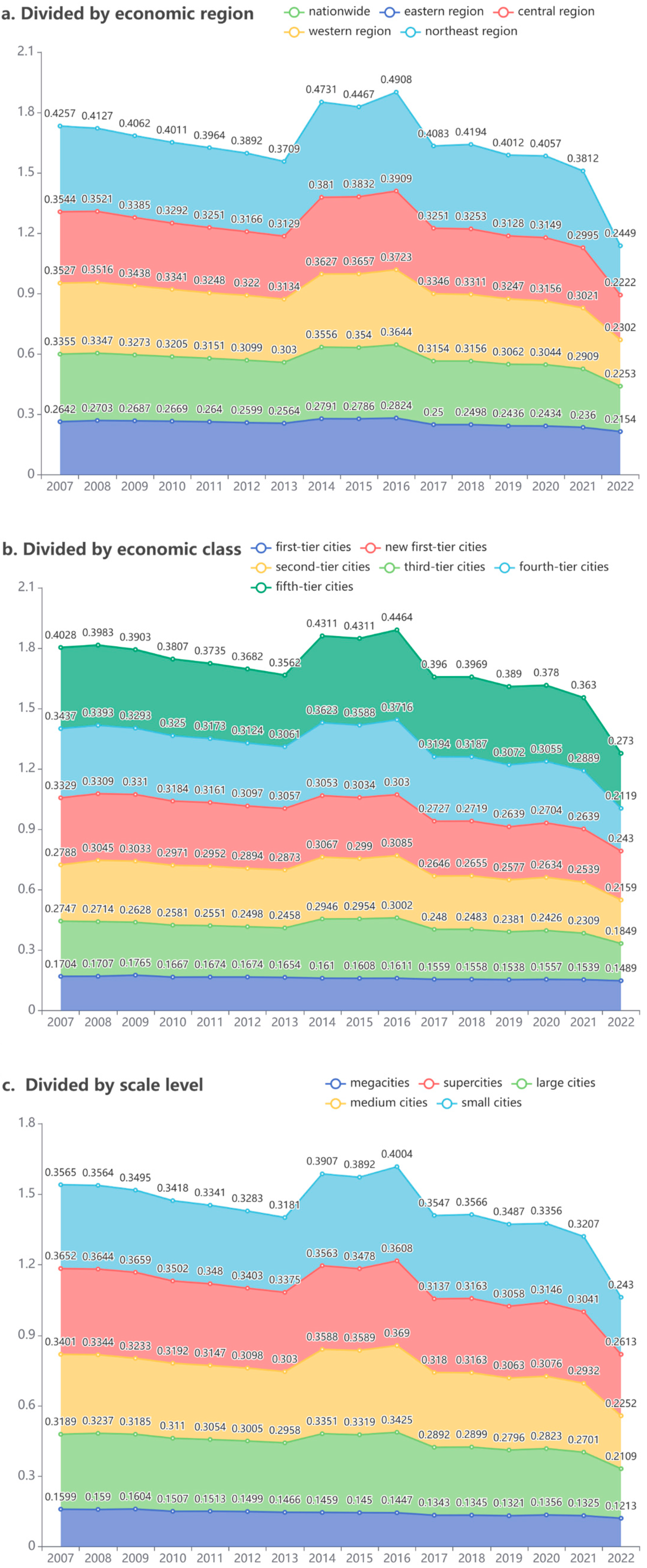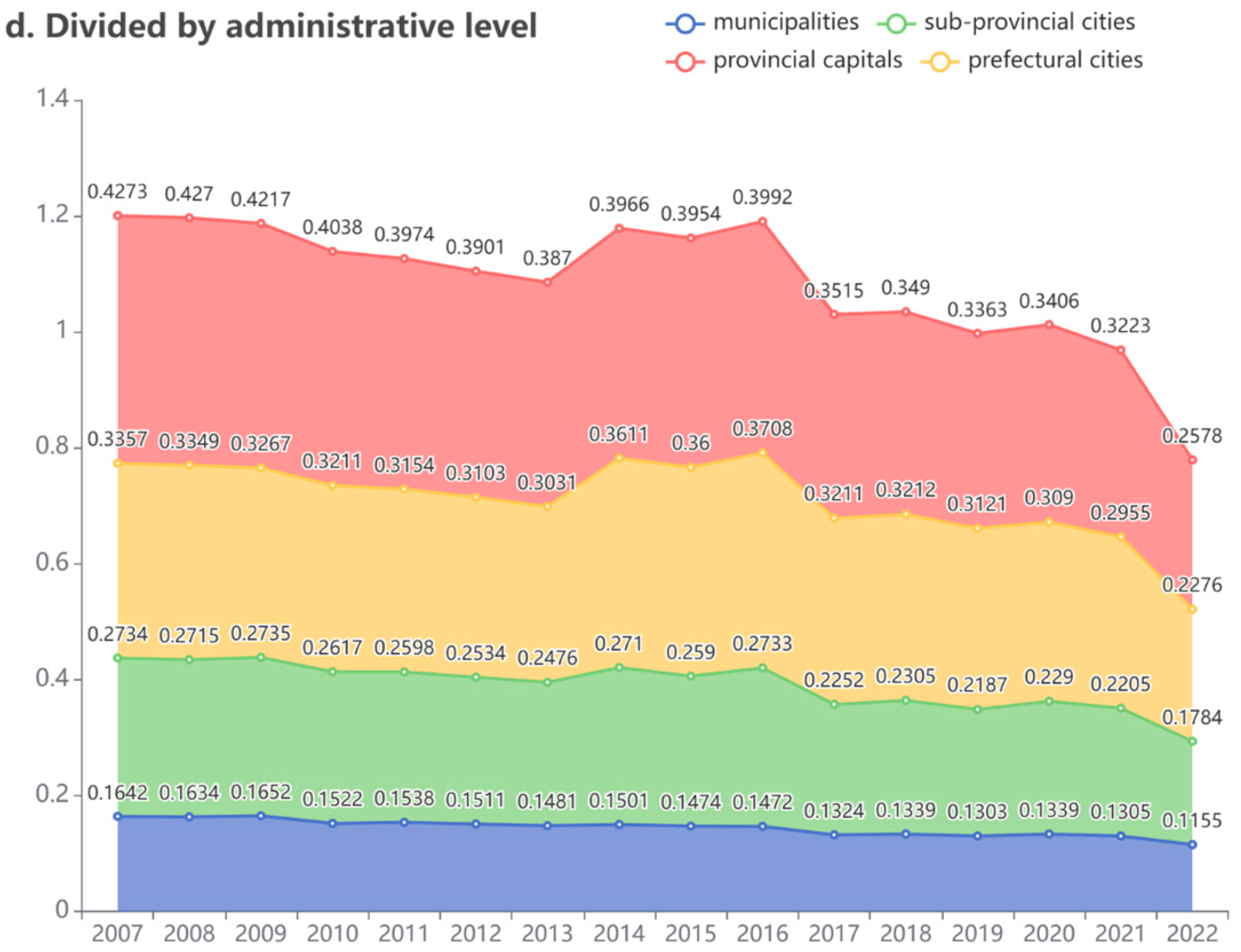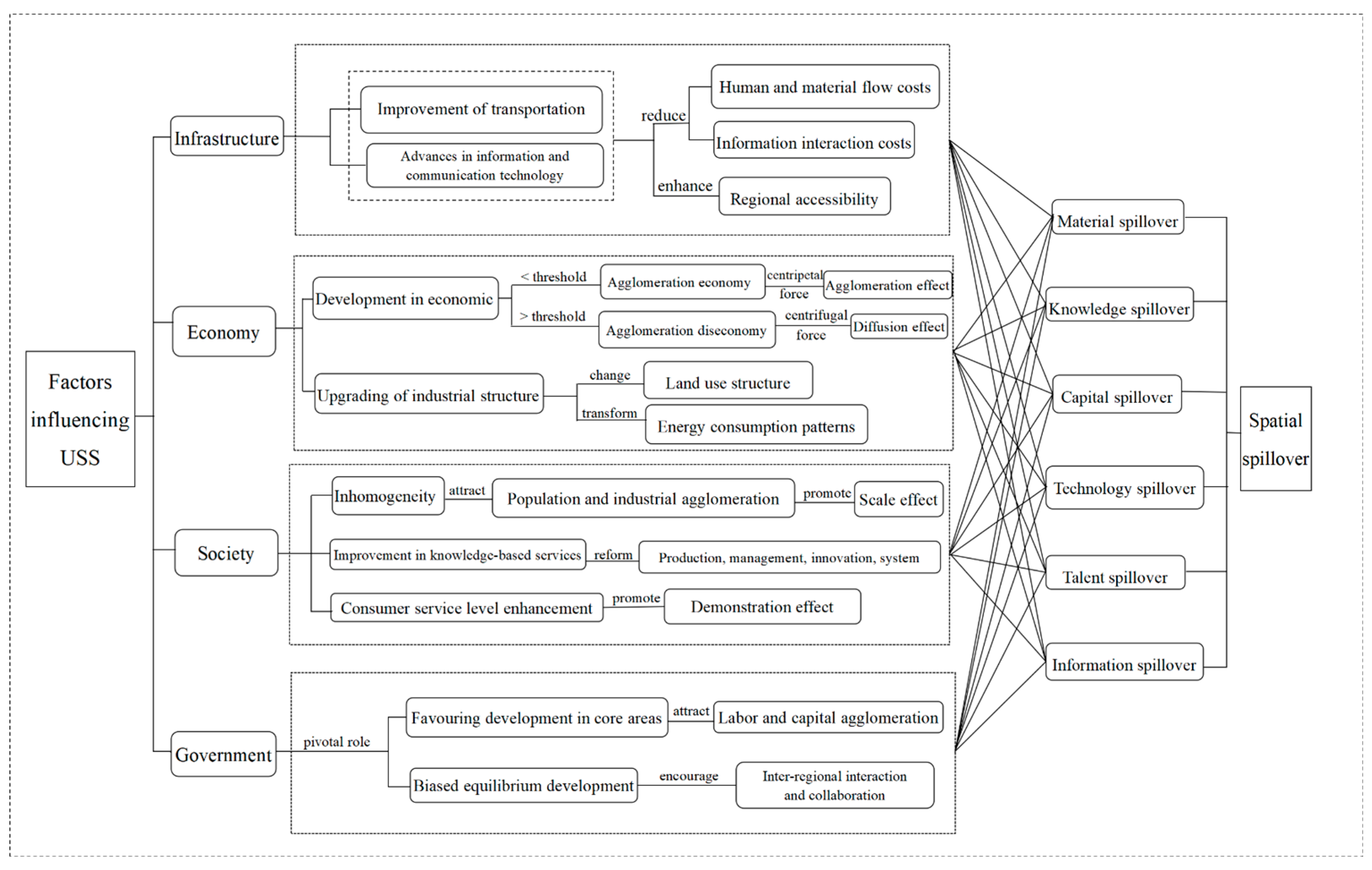1. Introduction
The urban spatial structure (USS) reflects the complex distribution and dynamic interplay of socio-economic activities within the physical landscape of cities, serving as a hot topic in disciplines such as urban geography, urban and rural planning, urban economics, and urban sociology [
1,
2,
3]. Goal 11 of the United Nations Sustainable Development Goals (SDGs) emphasizes the need to “Make cities and human settlements inclusive, safe, resilient, and sustainable” “
https://sdgs.un.org/goals (accessed on 2 February 2025)”. This goal seeks to enhance urban sustainability in response to the complex challenges of urbanization, including inadequate infrastructure, air pollution, traffic congestion, social inequality, and housing shortages. Additionally, it underscores the need for cities to adapt to climate change and natural disasters to improve the quality of life for all residents. USS plays a fundamental role in shaping a city’s functional layout, resource efficiency, and residents’ lifestyles, significantly influencing its sustainable development. A well-planned USS can effectively integrate various functional areas, shorten commuting distances, alleviate traffic congestion, reduce energy consumption, and enhance urban efficiency and sustainability [
4]. Moreover, a rational USS can optimize land use patterns, prevent uncontrolled urban sprawl, and protect the natural ecological areas surrounding the city. It also offers essential ecological services and green spaces, promoting environmental balance [
5]. Given its profound impact, the USS has become a focal point in urban planning and development, drawing significant attention from governments and all sectors of society. The New Urban Agenda highlights the importance of “enhancing spatial connections between housing and urban structures as well as their adjacent functional areas”. Concurrently, the 14th Five-Year Plan of China advocates for the judicious articulation of the USS to foster harmonious growth across cities and towns of various sizes. Amidst accelerated economic growth, technological advancements, and rapid urbanization, the USS has evolved with new characteristics such as “flow” space, spatial sharing economy, and digitalization, becoming a landscape shaped by increasingly intricate and multifaceted influencing factors. The systematic investigation of these determinants, grounded in a rigorous assessment of USS, has emerged as an important area of research. The research outcomes will be instrumental in providing policy recommendations that ensure sustainable urban development.
The USS typically exhibits two characteristics: monocentric and polycentric. A monocentric structure refers to the concentration of economic activities, population, infrastructure, and services in a central area, with peripheral areas relying on the resources and services provided by the core [
6]. In a monocentric USS, the central area attracts capital, talent, and technology from surrounding regions through the “polarization effect” and spreads these resources to peripheral areas via the “diffusion effect”. Over time, the surrounding areas develop under the influence of the central area, creating a dependency and forming a typical hierarchical structure resembling a “pyramid”. In contrast, a polycentric structure is characterized by multiple complementary centers within a city. Each center specializes in different functions, such as economics, culture, and social affairs, fostering the sustainable development of the entire city through cooperation and interaction [
7]. In a polycentric USS, no single central area holds absolute dominance; instead, a balanced development trend emerges. Each center facilitates the flow and sharing of resources, capital, and technology through an integrated transportation system, industrial cooperation, and functional division of labor.
Studies of USS have taken either morphological or functional perspectives [
8,
9]. Investigations from a morphological perspective have considered the aggregation and dispersion of factors, emphasizing the delineation of spatial distributions across these diverse elements [
10]. This approach relies on data for parameters such as population [
11,
12] and nighttime lights (NTL) [
13]. These studies have used analytical tools such as the Herfindahl–Hirschman Index (HHI) [
14] and the rank-size rule [
15]. For example, Liu et al. utilized population data to measure the degree of polycentricity in cities by analyzing the spatial distribution of population centers, thereby accurately depicting the subtle differences in the spatial structure of various cities [
16]. Riguelle et al. focused on European cities and quantified the polycentric characteristics of different cities based on employment distribution data [
17]. From a functional perspective, research has examined the critical functional interconnections across cities and proposed that the functional linkages are based on the flow of various factors [
18,
19]. Applying this analytical approach, researchers have examined flow patterns, including commuting [
20], social media [
21], mobile phone [
22], and taxi trajectory data [
23]. These studies aimed to assess the provision of additional functions beyond local needs and identify the compactness of urban center configurations, thus, enriching our understanding of USS. Using this approach, Wang et al. considered taxi trajectories data and identified the distinctly multi-directional, balanced polycentric setup of Shanghai, China [
24]. Zhang et al. used smart card data from 2013 to 2017 and conducted a multinomial logistic regression to document the evolution of USS in London, UK, toward an increasingly polycentric and compact structure [
25]. Burger et al. examined the development trends of the spatial structure of metropolitan areas in England and Wales using journey-to-work data between local authority districts [
26]. His research revealed significant differences in the evolution of spatial structures across cities.
Studies of the determinants shaping USS have been conducted in various disciplines, emphasizing distinct facets of urban development. Urban planning, as the progenitor of USS studies, has adopted concepts like garden cities, edge cities, and satellite towns, underscoring the pivotal role of infrastructure in mitigating urban challenges such as traffic congestion and environmental degradation [
27]. Song et al. quantified the subway network’s impact on USS optimization [
28]. In contrast, urban geography, focusing on land use types, has explored the significant influence of industrial characteristics on the evolution of USS. In the field of new economic geography, which attempts to understand the effects of scale economies, studies have focused on the evolution of USS under the effect of economic activity [
29]. Zhang et al. studied the Kunming–Yuxi Urban Agglomeration in China using big data and a geographical detector, revealing the impact of per capita GDP on USS over time [
30]. Studies in urban sociology have ventured further, investigating the profound influence of human behavior and societal activities on USS [
31].
A thorough review of the existing literature revealed that significant advances have been made in measuring USS and identifying its determinants, substantially enriching the theoretical framework and policy dialog surrounding USS. However, these studies have several limitations. (1) A reliance on traditional statistical and big data has impeded the objective comparison of USS across various cities and has prevented a cohesive analysis of nationwide USS evolution and characteristics. (2) Studies using metrics such as the HHI, Pareto index, and primacy index extend to the level of urban agglomerations or macro-regions, amalgamating data across entire agglomerations or regions, which obscures the finer details at the city or municipal level. Given the pivotal role of municipal areas in orchestrating the “daily life circles” of residents, facilitating the equitable distribution of public resources, and fostering urban–rural integration, a focused examination of municipal-level USS is critical. (3) Existing research has targeted the influence of a single factor on USS, preventing a comprehensive analysis and integration from a systemic perspective.
With the rapid development of China’s economy and the acceleration of urbanization, the gap between urban and rural areas has widened, leading to increasingly prominent issues such as uneven resource allocation, social stratification, and worsening environmental pollution. Additionally, spatial imbalances—such as uncontrolled urban expansion, growing separation between employment and residential areas, and prolonged commuting distances—have become more severe. To effectively address these challenges, it is crucial to scientifically measure and analyze USS. Understanding the characteristics and influencing factors of USS holds significant theoretical and practical value for formulating more informed regional development policies and promoting coordinated urban growth. Moreover, it has far-reaching implications for sustainable urban development, resource optimization, social equity, and environmental protection, all of which are essential for ensuring the healthy evolution of modern cities. To this end, our study encompassed 292 prefecture-level and above cities in China from 2007 to 2022, using district and county-level NTL data and the HHI to delineate the USS. We established a theoretical framework and applied the spatial Durbin model (SDM) to explore the intricate interplay between the factors that influence USS.
This study makes innovative contributions in three key areas. The first is the innovation in the method of measuring USS. Traditional research methods typically rely on various statistical indicators, which are often constrained by data quality and accessibility. These methods fail to capture the dynamic changes in USS adequately. In contrast, this study employs a combination of NTL data and HHI as a measurement tool for USS. NTL data directly reflects the intensity, distribution, and changes in urban artificial lighting at night, which is strongly correlated with urban economic activities, population distribution, and social vitality. By using NTL to calculate the HHI, the study improves the accuracy of measuring USS, offering a more comprehensive and objective assessment compared to traditional statistical methods. This approach effectively overcomes the one-sidedness and limitations inherent in conventional metrics. The second innovation lies in the research scale. Unlike previous studies, which primarily focus on urban clusters or macro-regions, this study examines 292 cities in China. This scale allows for a deeper understanding of USS and provides insights into the “daily life circles” of residents. By analyzing different types of cities, the study reveals the complexity and variability of USS across diverse contexts. The third innovation concerns the factors that influence USS. Traditional research often focuses on a single factor, yet the formation and evolution of USS is a multidimensional and multilevel process influenced by a range of factors. Through constructing a comprehensive theoretical framework, this study systematically integrates four key dimensions—namely infrastructure, economy, social factors, and government intervention—and explores how these factors shape USS from multiple perspectives. Furthermore, the study employs an SDM to account for spatial spillover effects, revealing that the impact of a particular factor on USS is not confined to the local area but may extend to neighboring regions, generating similar or differing effects.
The subsequent sections are arranged in the following order.
Section 2 delineates the data sources and methodologies employed, encompassing NTL data, geographic information, and the datasets used for analyzing factors influencing USS. It also describes the analytical tools used, including the HHI and SDM.
Section 3 presents the research findings, illustrating the evolution of USS over the study period and the theoretical analytical framework used to systematically analyze the impact of multiple elements on USS. This information is supplemented by the results of robustness and endogeneity tests.
Section 4 discusses how our measurements of USS in different cities are compared. It also discusses the factors influencing USS, highlighting the contributions and innovations of our research and addressing its potential limitations.
Section 5 is the concluding section. It synthesizes the study’s findings and translates them into actionable policy insights, with the aim of informing future urban development strategies and facilitating sustainable urban growth.
4. Discussion
It was found that the USS in China predominantly exhibited a polycentric trend. This can be attributed to the increase in urban populations, the extension of urban regions, and the continuous improvement of urban transportation networks, which have tightened the economic and social connections between various urban regions. The diverse demands of industries and services have led to socio-economic development across multiple nodes, further advancing the shift toward a polycentric USS. In comparison with existing studies of urban agglomerations, Lan et al., based on NTL, calculated HHI from monocentric and polycentric perspectives and identified a pronounced polycentric trend across Chinese urban agglomerations [
52]. Li and Zhang used NTL in combination with urban economic statistics, and the results indicated that national-level urban agglomerations with robust economic foundations and advanced developmental stages had a significantly higher degree of polycentric structures compared to regional urban agglomerations with weaker economic bases [
63]. Accordingly, the findings of this study, which focused on cities, were aligned with those of previous studies examining urban agglomerations, confirming a widespread polycentric trend both in urban agglomerations and prefecture-level cities across China. This study enhanced the scope of USS research at the city level by assessing it within prefecture-level cities.
In previous studies, researchers determined the USS of individual cities [
64,
65]. For instance, Huang et al. used enterprise registration data from 2010 to explore the spatial distribution of employment in Beijing and concluded that the city’s USS is transitioning toward a polycentric structure [
66]. Xie et al. used geographic information system data to create maps visualizing spatial development patterns and conducted a quantitative analysis as part of a spatiotemporal impact assessment [
67]. They concluded that Shenzhen is also progressing toward a polycentric USS. Yue et al. analyzed Hangzhou’s expansion direction, urban–rural gradient, and growth types, and discussed the evolution of a polycentric USS [
68]. Consequently, the results of their study, which encompassed all cities in China, were consistent with findings from individual city-focused research, indicating a universal trend toward polycentric structures in Chinese cities. By analyzing 292 cities in China, the present study systematically explored the evolutionary trends and spatial characteristics of USS at the national scale. The results enabled a comparative analysis of various cities, yielding highly credible research findings.
The factors influencing USS were examined, and it was discovered that improvements in transportation infrastructure and upgrading industrial structures have contributed to a monocentric trend. Additionally, economic growth initially promoted a trend toward monocentric structures, which subsequently shifted toward polycentric structures. In contrast, Sun et al. used panel data models to explore the evolution of USS in urban agglomerations and noted that enhancements in transportation infrastructure, as indicated by per capita road area, favored monocentric development [
62]. Sun et al. examined the issue from a functional connections perspective and found that agglomerations with a substantial tertiary sector were more likely to develop monocentric structures. Moreover, the USS in urban agglomerations shifted from monocentric to polycentric structures as economic development progressed [
55]. Accordingly, regarding the factors that influence USS, the findings of this study, focusing on cities as the unit of analysis, were aligned with those related to urban agglomerations, highlighting a prevalent polycentric trend across both urban agglomerations and prefecture-level cities in China. Contrary to Lan et al., who concluded that human capital could encourage the polycentric development of USS, the present study found that the number of university students did not have a significant impact on the USS [
52]. This variation may stem from the choice of research units. The representation of human capital by the number of university students may be more fitting at a broader geographic scale, such as provincial or urban agglomeration levels. This study surpassed the existing literature by comprehensively examining factors from infrastructure, economy, society, and government to investigate the drivers of USS development in China. It also accounted for the geographical location, development stage, and unique characteristics of different cities, thereby proposing tailored USS development strategies that suite their specific development features and needs. This approach broadened the scope of research on the drivers of USS at the urban scale.
This study significantly enhanced the existing research on China’s USS, providing both academic and practical insights into the current structures of various city types across the nation and informing development strategies that encourage sustainable urban progress. The study highlighted the pivotal role of spatial development patterns in shaping urban dimensions and trajectories, offering a robust quantitative framework for assessing the real USS in China and its dynamic shifts over time. By systematically quantifying the determinants of USS, the research facilitated the maximization of synergies among various drivers, thereby aiding in the refinement of urban layouts and accelerating high-quality urban development and regional synchronization. Despite these advances, there remains a need for further in-depth studies.
First, this paper primarily focuses on analyzing the urban morphological spatial structure. However, studying USS from a functional perspective also holds significant theoretical and practical value. The theoretical foundation of studying urban functional spatial structure is based on the idea that urban regions are interconnected through various “factor flows”, including trade, population, information, and capital flows. The existing methods for measuring functional USS can be categorized into three types. The first type is the social network analysis method, which examines the interactions and connectivity between different functional areas by constructing a network relationship between them, thereby revealing the spatial structure characteristics of urban functional layouts. The second type is the rank-size rule, which identifies the hierarchical and polycentric nature of urban functional distribution based on the scale of urban functional units and their ranking within the spatial network. For instance, Burger et al. used commuter flow data and the rank-size rule to measure the degree of functional polycentricity in the Netherlands [
69]. The third category is the standard model comparison method, with the connection-domain model proposed by Vasanen being a notable example [
20]. The core idea of this model is to reveal the actual degree of interaction and spatial structure characteristics among urban centers by comparing and quantifying the similarity between the connection domain (i.e., the actual functional connection range) and the potential domain (i.e., the theoretical connection range derived from the theoretical distance or potential model). A high similarity between the two indicates that the city exhibits a trend toward a polycentric USS. The functional perspective provides an understanding of the interactive relationship between urban space and human activities, identifying the functional attributes of different regions, optimizing land use and resource allocation, and improving the scientific and rational nature of urban planning. This, in turn, helps cities become more resilient and sustainable in the face of population growth, industrial changes, and shifts in social demand. Therefore, future studies should further enhance the comparative analysis of morphological and functional perspectives, explore the internal relationships and interaction mechanisms between them, and expand the scope of research and its application value.
Second, this paper clearly focuses on the impact of human factors on USS, primarily discussing how infrastructure, the economy, society, and government intervention collectively shape urban spatial arrangements. Human factors play a vital role in urban planning and development, directly influencing the aggregation, expansion, and interrelations of various urban areas. However, the role of natural factors—such as terrain, climate, and disaster risks—cannot be overlooked. Natural factors may significantly affect the evolution of USS, impacting aspects such as urban habitability, accessibility, and disaster risk management. A deeper exploration of the role of natural geographical conditions is crucial to understanding the formation and development of cities. In particular, it is essential to examine how natural factors like geographical location, terrain, climate, and resources shape the formation and evolution of USS. These natural conditions not only determine the city’s livability and development potential but also influence inter-regional resource distribution and functional layout, ultimately shaping the city’s spatial pattern and functional zoning. Favorable natural conditions can provide initial competitive advantages, attract populations, and promote urban expansion and development. For example, Xiong et al. employed the fluctuation index and distribution proportion index model, combined with geographic information system (GIS) analysis, to explore the impact of topographic factors on the USS evolution during urbanization [
70]. Therefore, future research will focus on effectively integrating natural factors into the existing framework, offering a more comprehensive perspective for analyzing USS. By examining the interaction between natural and human factors, the complex driving mechanisms can be more deeply analyzed, providing more accurate theoretical support and a solid decision-making foundation for urban planning and sustainable development.
Third, potential data biases and calibration issues may arise with NTL data. First, NTL data are derived from satellite sensors such as DMSP-OLS and SNPP-VIIRS, which may have calibration problems. These sensors can show varying sensitivity over time or differences between individual sensors, leading to inconsistencies in the data. Second, NTL data are typically collected over different periods and can be influenced by seasonal changes (such as variations in day and night length or weather conditions) or time-specific factors (such as holidays, festive events, or daily lighting schedules), which may impact the accuracy of long-term trend analysis. Finally, the availability of NTL data can be affected by transient light sources and background noise. For example, auroras may interfere with the sensor’s ability to detect nighttime light in mid-to-high latitudes, resulting in missing data. In reference to the study by Wu et al., the dataset used in this paper consists of corrected DMSP-OLS-like data for China from 2007 to 2022, which integrates DMSP-OLS and SNPP-VIIRS data [
37]. The data processing method is as follows: First, DMSP-OLS data are calibrated using a secondary model based on the pseudo-invariant pixel method to address inconsistencies between different satellite data. Second, an exponential smoothing model is applied to predict and fill missing values in the monthly SNPP-VIIRS data. Annual SNPP-VIIRS data are then generated through a synthesis method, and noise is removed. Next, the SNPP-VIIRS data, resampled using the kernel density method, is converted to SDMSP-OLS data via a cross-sensor conversion method. Finally, SDMSP-OLS data (2013–2022) is appended to the calibrated DMSP-OLS data (2007–2022) to integrate the improved time series of DMSP-OLS-like data. These data processing techniques have somewhat mitigated the aforementioned issues and effectively reduced potential errors. However, future research should further refine the methods for addressing bias and calibration problems in NTL data to provide a more accurate foundation for scientific analysis.
Finally, considering China’s extensive and varied landscape, which is marked by distinct historical, natural, and cultural contexts, it will be necessary to diversify studies and consider how these different settings affect USS.









